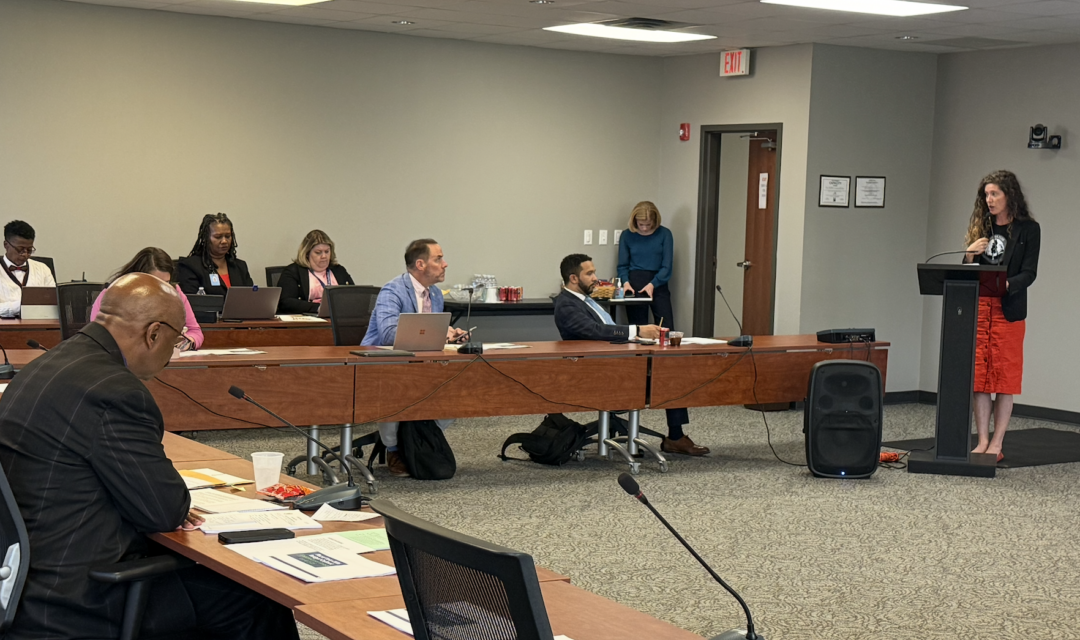Many, many Oak Ridge residents really, really don’t want a new methane pipeline project running right smack through their town and this week they let the county commissioners hear about it.
The Guilford County Board of Commissioners held a work session on Thursday afternoon, April 17, in the large third-floor conference room of the county-owned BB&T building in downtown Greensboro. One reason for the work session was to hear from Oak Ridge residents who are concerned about a proposed expansion of the Williams-Transco pipeline – a project currently under review by the Federal Energy Regulatory Commission (FERC).
While representatives from Transco were expected to attend the meeting, Chairman of the Guilford County Board of Commissioners Skip Alston announced at the start that no one from Transco was able to be there. Alston said the board would make arrangements to hear from Transco at a future date.
About a dozen Oak Ridge residents attended the meeting to show their opposition to the Southeast Supply Enhancement Project (SSEP), which would add a new segment of pipeline through their community. Residents have come to the commissioners’ regular meetings in the past to express their deep concern over issues ranging from pipeline safety and the risk of explosions to environmental degradation, potential water pollution, and the threat of losing property through eminent domain.
Caroline Hansley, a lead organizer with the Sierra Club, delivered a highly detailed speech outlining the scope of the project and why she and others oppose it. According to Hansley, the project would transport an additional 1.6 million dekatherms of methane gas per day by constructing two new pipeline segments in Virginia and North Carolina.
The plan also involves expanding compressor stations in five southern states.
Hansley noted that roughly 93 percent of the gas from the expansion would go to three large companies and be used primarily for power generation. To give a sense of scale, she said the amount of methane to be transported is equivalent to filling approximately 18,000 Olympic-sized swimming pools per day. The pipeline, with its 42-inch diameter, would operate under extremely high pressure, she said.
Although the project is being driven by Williams-Transco, it is FERC—the federal agency responsible for regulating interstate natural gas pipelines—that holds the final decision-making authority.
Hansley criticized FERC for opting to conduct an environmental assessment rather than a more comprehensive environmental impact statement. This, she said, ignored more than 7,000 public comments, almost 100 nonprofit organizations, over a dozen North Carolina legislators, the mayor of Oak Ridge, and many county commissioners.
Residents hope the Guilford County commissioners will join them in fighting the project or at least ensuring it is done in a very safe way.
At the meeting, Hansley also raised concerns about the timing of the process.
The North Carolina Department of Environmental Quality recently announced that Transco intends to submit both air and water permit applications necessary for SSEP within the next two weeks. She argued that local governments should act quickly to pass resolutions of opposition so that FERC will consider them during its formal record review.
According to Hansley, the gas being transported—methane, or “natural gas”—has climate impacts comparable to coal, particularly when leaks are considered across the entire production and transportation process. She said this worsens climate change and raises energy costs, which, she said, will be passed on to ratepayers.
She also emphasized the safety risks of running the pipeline through densely populated areas. In Oak Ridge alone, she said, there are already three high-diameter, high-pressure fracked gas pipelines. The new pipeline would run alongside them, creating additional danger due to “co-location,” the practice of building a new pipeline beside existing ones.
Hansley listed several institutions within the potential blast and evacuation zone: Oak Ridge Weekday School, Oak Ridge Elementary School, Oak Ridge Military Academy, Oak Ridge First Baptist Church, and St. James AME Church.
She said the potential impact radius includes dozens of homes as well, and she encouraged commissioners to visit the area and speak directly with affected residents.
She cited the Pipeline and Hazardous Materials Safety Administration’s guidelines and explained how “high consequence areas” are defined—areas where an accident could result in significant damage or loss of life.
Hansley also said that Transco has one of the worst safety records among US gas pipeline operators and that it ranks poorly in incidents, fatalities, cost per incident, and gas spills.
Economic concerns were also addressed that afternoon.
A recent analysis by a Cary-based energy consulting firm found Duke Energy’s proposed expansion of methane gas infrastructure could cost a typical residential customer more than $2,100 in additional power bills by 2038. Hansley said the SSEP alone is expected to cost $1.5 billion and would create minimal tax revenue or permanent jobs. Most of the temporary construction jobs, she added, would likely go to out-of-state contractors.
Hansley warned further of a broader trend: the overbuilding of energy infrastructure to meet projected data center demand. Utilities, she said, are financially incentivized to overbuild, and the cost of that overbuilding gets passed to everyday ratepayers. A recent report from the Institute for Energy Economics and Financial Analysis showed that utility projections for data center energy usage may be inflated. If that demand doesn’t materialize, communities could be stuck with costly and underused infrastructure.
The lack of serious consideration for renewable alternatives also drew criticism from Hansley. She said Transco’s environmental filings devoted just over a page to exploring renewable options. In her view, locking the region into decades of fossil fuel use ignores not only climate concerns but also economic prudence. She pointed out that wind and solar energy in the United States had outproduced coal for the first time in 2024, demonstrating a shift that she believes the region should be embracing.
She concluded by asking the commissioners to listen not only to her but also to the many residents who had submitted petitions, handwritten letters, made phone calls, and written to local newspapers, all urging Guilford County to pass a resolution opposing the pipeline.
Following Hansley’s remarks, County Attorney Andrea Leslie-Fite provided an overview of the legal and procedural framework surrounding the SSEP.
FERC, she explained, is the primary decision-maker and has the authority—granted by Congress—to approve, locate, construct and regulate interstate pipelines. The agency’s process includes gathering comments from both the public and various governmental bodies.
Fite shared that Transco submitted its application on October 29, 2024, seeking a certificate of public convenience and necessity under the Natural Gas Act. FERC issued a formal notice of application on November 12, which triggered a requirement for other federal agencies involved in the permitting process to complete their reviews within 90 days of the environmental assessment.
The environmental assessment is currently underway, and a final decision is expected by February of next year. Fite emphasized that, although FERC opted for an environmental assessment rather than a full environmental impact statement, that decision could still be revisited.
She added that other jurisdictions have successfully petitioned for such a change based on public input.
In Guilford County, the proposed pipeline would involve the construction of about 24 miles of 42-inch pipeline and it would affect not only Guilford but also Forsyth and Davidson counties. Fite outlined the procedural steps: application, a notice of application, environmental review, and finally a decision from the commission. She urged the public to continue submitting comments through the FERC website, noting that every public comment becomes part of the official record.
Commissioner Mary Beth Murphy asked about comparisons made during the meeting to similar projects in Alamance County and whether Guilford’s actions could have similar weight. The county attorney responded that while public comments from local governments are considered, they are weighed based on the quality and specificity of the information provided. Any claims about safety or environmental impact should be supported by data in case the applicant—in this case, Transco—challenges them.
Commissioner Pat Tillman thanked the speakers for the information, saying, “It’s a serious issue and we take it seriously.”
Chairman Alston reiterated that he wished Transco had attended.
“I like to hear both sides,” he said.
He added that Guilford County owns Triad Park – one of the areas potentially affected by the pipeline route – and that the county may ultimately need to approve an easement for the project. That, he noted, could give the county some leverage moving forward.
The meeting concluded with no official action taken, but it was clear that the board—and the people of Oak Ridge —will all be closely watching the coming steps in the pipeline’s federal review process.


Makes sense. Why run a pipeline through a rural area when you could go through the middle of a large city? Twelve complainants should be enough to carry the day.
Good one! Quite right.
“He added that Guilford County owns Triad Park – one of the areas potentially affected by the pipeline route – and that the county may ultimately need to approve an easement for the project. That, he noted, could give the county some leverage moving forward.” He being Commissar Alston. Oh and look, he is lining up a potential CYA by having County property involved.
Add to this “A recent analysis by a Cary-based energy consulting firm found Duke Energy’s proposed expansion of methane gas infrastructure could cost a typical residential customer more than $2,100 in additional power bills by 2038.”
Right now I’m giving it 51-49% chance of passing the County Commissars with Skippy leading the charge. After all, it’s not his potential $2,100 additional power bill.
It is indeed disappointing that TRANSCO didn’t have someone to refute information provided by the Sierra Club. Hearing one side of an issue, and letting that information drive your fears and concerns is folly. Future meetings must include TRANSCO, if we’re to make a decision based upon facts.
Just the statement alone that methane and natural gas has an impact similar to coal leaves me dubious of any statement made. I will hold my opinion until all the facts are known.
Guilford County oxymoron: “work session”.
“Many, many” Oak Ridge residents oppose the project and about a dozen show up! The presenter cites inflated safety issues to mask the environmental issues which I believe are the underlying concerns of the organization raising the issue. The Sierra Club should welcome expanded use of natural gas over coal and even atomic energy. They are the ones creating the commotion!
* Well, I have lived in Oak Ridge for 20 years now, and nobody – but nobody – cares about this issue.
If they want to build this pipeline (which is the safest and least costly way to transport the fuel), by all means let’s proceed. America has growing energy needs. This pipeline will help.
“About a dozen Oak Ridge residents….” were against it. Let me guess: retired graying liberal former hippies with nothing else to do all day but demonstrate their saintliness.
It’s time for them to move on. Or pass on.
They had to kill time between Elon Musk protests
al hare,
While I find myself in agreement with you about 95% of the time, I’m afraid I am on the opposite side here, with all due respect.
How pathetic are the fear-mongers about a pipeline under Oak Ridge, when residents in this area have been sitting atop the Colonial pipeline for over 50 years without an incident, and the amount of oil it transports is tremendous! Not only that, but the tank farm near the airport would cause more of an issue than a pipeline, and in my lifetime going back to the 50s, I can remember only one fire out there! Get over yourselves!